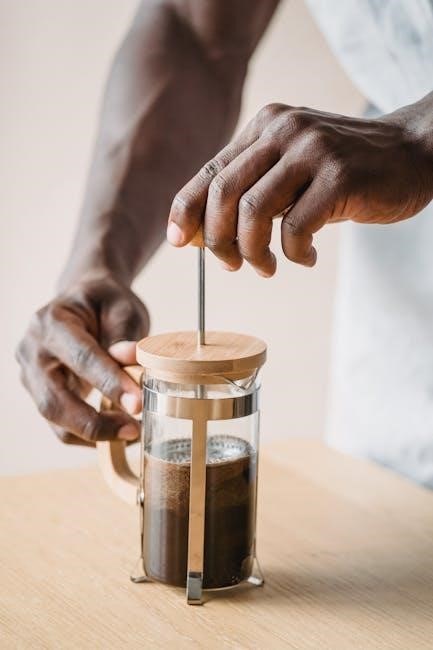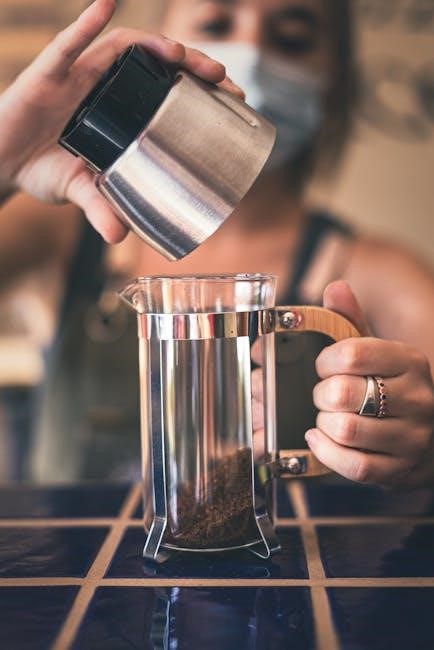The French Press is a traditional coffee brewing method known for its simplicity and rich flavor․ It involves steeping coarse coffee grounds in hot water, then pressing the plunger to separate the liquid․ This technique allows coffee oils and nutrients to remain, resulting in a bold and full-bodied cup․ Perfect for coffee enthusiasts, it requires minimal equipment and offers a foolproof way to enjoy flavorful coffee at home․
Materials and Equipment Needed
To brew French Press coffee, you’ll need a French Press coffee maker, coffee beans, a grinder, a kettle, and a timer․ These tools ensure a perfect brewing experience․
- A French Press coffee maker for steeping and plunging․
- Coffee beans for freshness and flavor․
- A grinder to achieve the right coarse grind․
- A kettle to heat water to the ideal temperature․
- A timer to monitor the steeping time accurately․
French Press Coffee Maker
The French Press coffee maker is a cylindrical pot with a plunger that includes a fine metal or nylon mesh filter․ It’s designed for steeping coarse coffee grounds in hot water, allowing oils and nutrients to infuse, creating a rich, bold coffee․ Available in glass or stainless steel, sizes range from small (3-4 cups) to large (8-12 cups)․ Popular models like Bodum Chambourd are durable and easy to clean, ensuring consistent brewing․
Coffee Beans and Grinder
Fresh, high-quality coffee beans are essential for a perfect French press․ Use a coarse grind to ensure optimal extraction․ A burr grinder is recommended for consistency, while blade grinders can generate heat, which may alter the flavor․ Aim for a 1:15 coffee-to-water ratio, adjusting based on personal preference․ Choose beans that suit your taste, whether light, medium, or dark roast, to enjoy a rich and flavorful brew․
Kettle and Timer
A kettle is essential for heating water to the ideal temperature (195°F to 205°F) for French press brewing․ Use fresh, filtered water for the best flavor․ A timer helps manage the steeping time, typically 4 minutes, ensuring optimal extraction․ Preheat the French press by rinsing it with hot water before adding coffee grounds․ This step ensures even extraction and prevents temperature loss during brewing, leading to a richer, more balanced cup of coffee․
A Step-by-Step Guide to Brewing French Press Coffee
Boil water, add coarse grounds to the preheated French press, pour water, let steep for four minutes, press slowly, and serve immediately for a perfect cup․
Preparing the French Press
Start by cleaning the French press thoroughly to remove any residual coffee oils․ Rinse it with hot water to ensure it’s preheated․ Pour out the rinse water and let it dry slightly․ This step ensures a fresh, untainted flavor for your brew․ Make sure all parts, including the plunger and lid, are clean and ready for use․ A properly prepared French press is essential for achieving optimal flavor․
Adding Coffee Grounds and Water
Measure and add coffee grounds to the preheated French press․ Use 65 grams of coffee per liter of water for a balanced brew․ Grind the beans to a coarse texture to ensure proper extraction․ Pour hot water (around 195°F) over the grounds, saturating all of them․ Stir briefly to distribute evenly․ Avoid overfilling; leave space for the plunger․ Start your timer immediately to monitor the steeping process accurately․

Steeping and Plunging
Allow the coffee to steep for 4 minutes to extract the full flavor․ After steeping, slowly press the plunger down to separate the grounds from the liquid․ Be careful not to press too quickly, as this can stir up sediment and make the coffee bitter․ Once plunged, pour the coffee immediately into your cup to stop the brewing process and enjoy the rich, dense texture of French Press coffee․
Serving the Coffee
Pour the freshly brewed coffee immediately after plunging to prevent over-extraction․ Serve within 20 minutes for optimal flavor and temperature․ Enjoy as is or customize with milk, sugar, or cream to suit your taste․ For a richer experience, consider pairing it with pastries or snacks․ French Press coffee is perfect for sharing, making it a great option for hosting guests or savoring alone․

Optimal Brewing Parameters

Use a 1:15 coffee-to-water ratio, coarse grind, and 4-minute steep at 195-205°F for balanced extraction․ Adjust ratio, grind, and time to suit taste preferences․
Coffee-to-Water Ratio
The ideal coffee-to-water ratio for French Press is 1:15, meaning 65 grams of coffee per liter of water․ For a standard 350ml French Press, use 21g of coffee․ This balance ensures a rich, full-bodied flavor without over-extraction․ Adjust the ratio to suit your taste preferences—more coffee for a bolder cup or less for a lighter brew․ Consistency in measurement is key to achieving optimal extraction and flavor․
Grind Size and Distribution
A coarse grind is essential for French Press to prevent over-extraction and ensure smooth flavor․ The grind should resemble coarse rock salt, allowing for even extraction during steeping․ Distribute the grounds evenly in the French Press to avoid dry spots․ This ensures all coffee is saturated with water, promoting balanced extraction and a rich, full-bodied cup․ Proper grind size and distribution are critical for achieving the perfect brew․

Steeping Time and Temperature
The ideal steeping time for French Press is 4 minutes, allowing the coffee to develop its full flavor without becoming bitter․ Use water at 195°F to 205°F for optimal extraction․ Preheat the French Press to maintain temperature consistency․ Adjust steeping time to suit your taste: shorter for a lighter cup, longer for a bolder one․ Proper temperature and timing ensure a balanced and flavorful brew․
Tips for Making Perfect French Press Coffee
Use fresh, high-quality beans for optimal flavor․ Ensure the right coffee-to-water ratio and grind size for even extraction․ Experiment with steeping times to find your perfect balance of strength and nuanced flavor․

Choosing the Right Coffee Beans
Selecting high-quality, freshly roasted coffee beans is essential for a perfect French press․ Opt for light to medium roasts to preserve the coffee’s natural acidity and nuanced flavors․ Consider single-origin beans for distinct regional profiles or blends for balanced complexity․ Ensure beans are ground immediately before brewing to maintain aroma and flavor․ The right beans will elevate your French press experience, offering rich and satisfying results every time․
Avoiding Common Mistakes
Avoid using boiling water, as it can burn the coffee․ Ensure a coarse grind to prevent over-extraction and a muddy texture․ Don’t overfill the French press, as this can lead to overflow during plunging․ Avoid steeping for too long, as it may result in bitterness․ Lastly, don’t press the plunger too forcefully, as it can introduce sediment into the coffee․ These simple adjustments will help you brew a smoother, more balanced cup every time․
Experimenting with Variations
Explore beyond traditional French press by adjusting steeping times or ratios․ Try a shorter steep for brighter notes or longer for deeper flavors․ Experiment with cold brew by steeping grounds in cold water overnight․ Add spices like cinnamon or nutmeg for unique twists․ For a creamy touch, mix in milk or creamers post-brew․ Even steeping loose-leaf tea in your French press can yield delicious results, offering versatility beyond coffee․

Cleaning and Maintenance
Regularly clean your French press with warm water and mild detergent to prevent oil buildup․ For tougher stains, mix baking soda and water for a gentle scrub․

Regular Cleaning Practices
Regular cleaning is essential to maintain your French press’s performance and hygiene․ After each use, rinse the container and plunger with warm water to remove residual coffee oils․ Use mild detergent for a deeper clean, avoiding harsh chemicals that might damage the material․ For tougher stains, mix baking soda and water to create a gentle scrub․ Rinse thoroughly to eliminate any residue, ensuring your French press remains in optimal condition for future brews․
Removing Old Coffee Oils
Removing old coffee oils is crucial for maintaining flavor and hygiene․ Mix baking soda with warm water to form a paste, then apply it to the interior and plunger․ Let it sit for 10-15 minutes to break down stubborn residue․ Scrub gently with a soft sponge or brush, rinse thoroughly with warm water, and dry․ This process ensures your French press stays free of rancid oils, preserving the taste of future brews․
Storing the French Press
After cleaning, store the French Press in a cool, dry place to prevent moisture buildup․ Avoid direct sunlight, as it may cause thermal shock to glass models․ For thermal French Presses, store them upright to maintain insulation․ Disassemble the plunger and lid for better drying․ Proper storage ensures longevity and prevents residual coffee oils from spoiling, keeping your French Press in excellent condition for future use․

The Health Benefits of French Press Coffee
French Press coffee retains coffee oils and nutrients, offering higher caffeine content and antioxidant properties compared to filtered methods, potentially benefiting heart health and energy levels․
Higher Caffeine Content
French Press coffee typically contains more caffeine than other brewing methods due to the longer steeping time and the fact that the coffee grounds remain in contact with the water throughout the process․ This method doesn’t use a filter, which can absorb some caffeine in other methods․ The result is a bolder, more robust cup with a higher caffeine concentration, making it ideal for those seeking an energizing coffee experience․

Retention of Coffee Oils and Nutrients
The French Press method retains coffee oils and nutrients that are typically absorbed by filters in other brewing methods․ This results in a more flavorful and aromatic coffee․ The immersion process allows the coffee grounds to release their natural oils and nutrients into the water, preserving the coffee’s integrity and providing a richer, more authentic drinking experience with added health benefits․
Antioxidant Properties
French Press coffee retains more antioxidants compared to filtered methods, as the coffee grounds remain in contact with water throughout brewing․ These antioxidants, naturally present in coffee, help protect against oxidative stress and may contribute to improved heart health and reduced inflammation․ The immersion process ensures a higher retention of these beneficial compounds, making French Press coffee a healthier choice for those seeking to maximize their coffee’s nutritional benefits․
The French Press method offers a perfect balance of simplicity and rich flavor, making it a timeless choice for coffee lovers․ By following the steps and tips outlined, anyone can craft a delicious cup․ Its versatility allows for experimentation, ensuring every brew is tailored to personal taste․ Embrace the tradition and enjoy the bold, full-bodied coffee that only a French Press can deliver, while appreciating its health benefits and ease of preparation․
